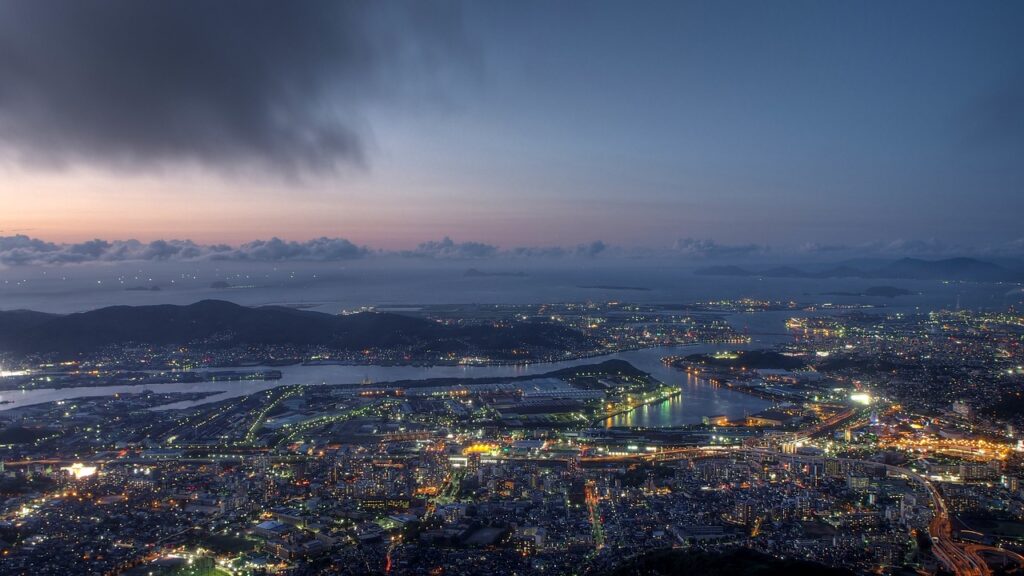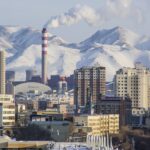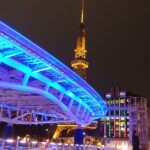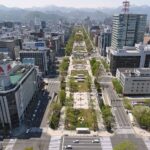Fukuoka’s excellent public transit network makes navigating the city a breeze. There are three different subway lines in this city. In addition, a well-established bus system connects the majority of the neighborhoods in Fukuoka. The islands of Shikanoshima and Nokonoshima are easily accessible by ferry from the city’s port. A network of toll highways connects Fukuoka to the rest of the prefecture for those who would rather drive.
Metro: basic information
The Fukuoka metro is an easy way to travel throughout the city. It has 37 stops along three lines (the Kuko, Hakozaki, and Nanakuma lines). Connecting the Kuko Line and Hakozaki Line at Tenjin station forms a loop line that travels in and out of the city. The Nanakuma Line runs from Hakata Station in the south to the Fukuoka Airport in the north. Using the Fukuoka metro is a convenient and inexpensive way to see the city.
The lines of the Fukuoka subway system
Line 1 (Kūkō) – Orange
It links Meinohama in Nishi Ward to Fukuokakko in Hakata Ward, which is home to Fukuoka Airport. The line appears as an orange tint on maps. The line connects directly with the JR Chikuhi Line. Automatic platform gates and an automatic train operation (ATO) system are standard fare on this line of the Fukuoka City Subway. However, the JR Chikuhi Line uses hand-operated cars. In all of Japan, this is the only subway line that travels directly to a terminal. Tokyo’s airports (Narita and Haneda) are accessible by the Toei Asakusa Line, but the airports themselves are not stops along the Asakusa Line. Instead, these are suburban line stations that the Asakusa Line connects to via through services.
Line 2 (Hakozaki Line) – blue
Subway riders in Fukuoka, Japan can take the Hakozaki Line, which is part of the Fukuoka City Subway system. Within Fukuoka, it links the neighborhoods of Nakasu-Kawabata in Hakata Ward to Kaizuka in Higashi Ward. Automatic platform gates and an automatic train operation (ATO) system are standard fare on this line of the Fukuoka City Subway.
Line 3 (Nanakuma Line) – green
Subway riders in Fukuoka, Japan, can take the Nanakuma Line, which is a part of the Fukuoka City Subway. Within Fukuoka, it travels between Hashimoto Station in Nishi Ward and Hakata Station in Hakata Ward. Automatic platform gates and an automatic train operation (ATO) system are standard fare on this line of the Fukuoka City Subway.
Map of Metro 2024: Free Download
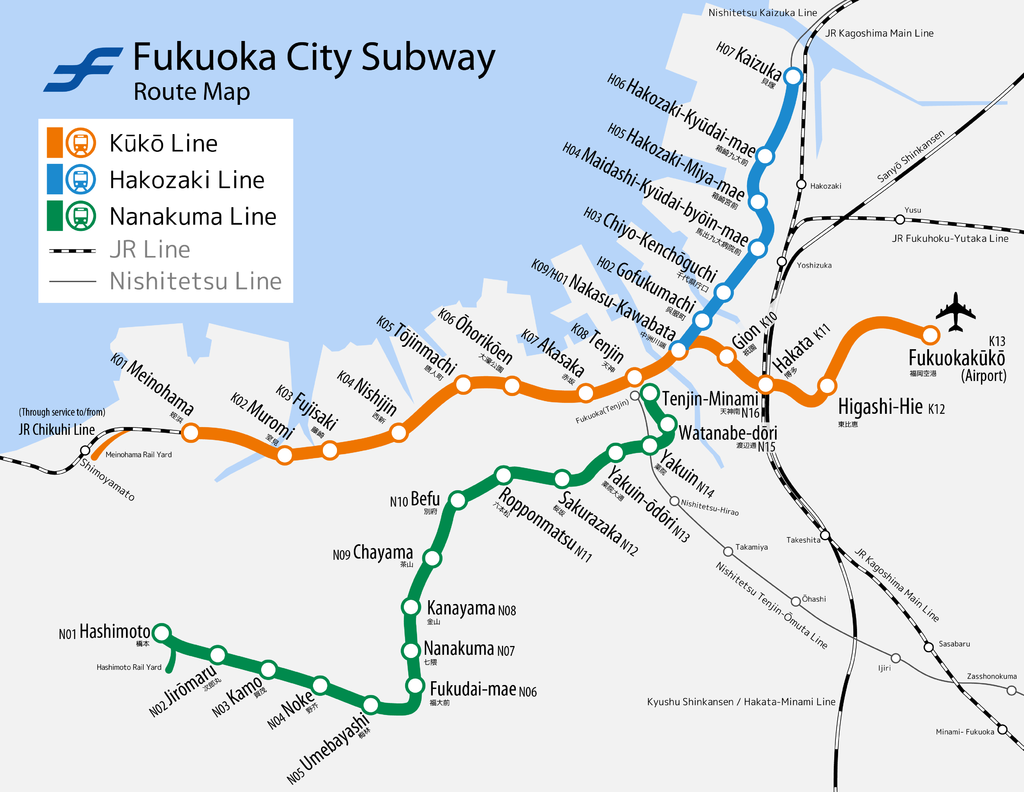
Click and download the map of Fukuoka’s underground system for 2024
The most up-to-date and detailed map of the Fukuoka metro system is found in Fukuoka Metro 2024. It features a comprehensive map of the metro system, complete with station names and connections. Commuters can get their hands on a copy without spending a dime by downloading it in PDF format. It also provides a straightforward map of the system to help you find your way around the metro with ease. Users may easily find their way to their destination station with the help of this map.
transport tickets in Fukuoka: Best types for travelers
The 1-day Fukuoka City Subway Pass is the most often purchased ticket by visitors. For just 830 yen, you may enjoy 24 hours of unlimited use of the Fukuoka City Subway and Nishitetsu Bus routes.
The Fukuoka City Subway 2-day Pass is ideal for tourists who will be in town for a few days and will be making frequent use of the subway system. For only 1,400 yen, you can travel the Fukuoka City Subway and Nishitetsu Bus lines as often as you like for a full two days.
Those staying for a week or more will benefit from purchasing a Fukuoka City Subway 7-day Pass. For 2,100 yen, you can ride the Fukuoka City Subway and Nishitetsu Bus routes as often as you like for an entire month.
The Fukuoka Tourist Passport is an excellent choice for visitors who intend to make extensive use of the city’s public transportation system throughout their trip. For 4,000 yen, you can travel the Fukuoka City Subway, any of the Nishitetsu Bus lines, and any of the Nishitetsu Railways as often as you like for a whole week.
The Fukuoka City Subway Day Pass is your best bet if you plan on making many trips all throughout Fukuoka. For 2,400 yen, you can take as many journeys on the Fukuoka City Subway and Nishitetsu Bus lines as you like for a whole day.
The Fukuoka City Subway 2-day Pass is the best value for those staying in Fukuoka for three days. This package is the best value, including two days of unlimited travel on the Nishitetsu Bus and the Fukuoka City Subway. In addition, guests can take as many journeys as they like, allowing them the flexibility to see Fukuoka at their leisure.
Summary of fares for public transport in Fukuoka
- For 830 yen, you can use the Fukuoka City Subway and Nishitetsu Bus systems for 24 hours.
- For 1,400 yen, you can ride as much as you want for two days.
- For 2,100 yen, you can ride the subway and buses for an entire week.
- For only 4,000 yen, you can ride the Fukuoka City Subway, any of the Nishitetsu Bus lines, and any of the Nishitetsu Railways for a whole week.
- The Fukuoka City Subway and Nishitetsu Bus Day Pass cost 2,400 yen and allow for unlimited use of the systems for a single day.
Timetables & Schedules of the Subway System
On weekdays, the Fukuoka Metro system runs from 5:30 a.m. to 12:30 a.m., while on weekends and holidays, it runs from 6:00 a.m. to 12:30 a.m. The trains run at different intervals throughout the day and on different days of the week. In the middle of the day, trains run every 5 minutes, whereas at night they run every 10. It is vital to check train schedules before making a trip, as the last train may leave earlier than the posted closure hour.
What Are Other Options for Public Transportation in Fukuoka?
The metro is just one of many public transit choices available to Fukuoka residents and visitors. Both the Nishitetsu Bus and the JR Bus provide service to the Hakata Port International Terminal and the Tenjin Minami Station, as well as other parts of the city and suburbs. The city’s streetcar network is very convenient for shorter journeys. The Fukuoka Airport Limousine Bus connects the airport with the city center, and the Fukuoka City Subway is another alternative for traveling around.
How does city bus transportation work in Fukuoka?
The Fukuoka City Transportation Bureau is in charge of running Fukuoka’s public bus service. It’s an extensive bus system that goes just about everywhere in the city. The bus system is convenient and has regular service. Most buses are modern and luxurious, with amenities like air conditioning, comfy seating, and even Wi-Fi and phone charging.
The three major bus lines in Fukuoka are the Yutoku Line, the Tenjin Line, and the Hakata Line. These three paths connect all the major parts of the city. The Yutoku Line travels north to south, and the Tenjin Line travels east to west across the city. The direction of the Hakata Line is from north to south. There is a network of smaller bus lines that serve the city’s other areas and suburban neighborhoods.
You can get a fare card for the buses in Fukuoka at a ticket-selling machine. The price depends on how far you’re going and what zones you’ll be going through. You can pay your fare using cash, credit, or a prepaid card.
How do the public trains work in Fukuoka?
The Japanese city of Fukuoka is a hive of activity, and the city’s extensive public train system helps to keep its residents and visitors connected. The Fukuoka City Transportation Bureau runs the city’s railways, which include both local and express options. The public train system provides numerous options for getting throughout the city and to other surrounding cities.
Both local and limited express lines travel all around Fukuoka, connecting the city’s various neighborhoods. Although the local trains are the slowest option, they stop more frequently and provide the most convenient means of navigating the city. However, the express trains go at a higher speed and have more spacious seats. You can travel between cities using any sort of train.
The Sanyo Shinkansen, the Tohoku Shinkansen, and the Kyushu Shinkansen are the most useful trains for getting to neighboring cities. The Tohoku Shinkansen travels north to Tokyo, while the Sanyo Shinkansen links Fukuoka and Hiroshima in the west. The newest route, the Kyushu Shinkansen, runs from Fukuoka to the southern city of Kumamoto.
Several local lines, in addition to the long-distance trains, link Fukuoka to the surrounding cities. There are several main lines in Japan, the most well-known of which are the Sanyo, Kagoshima, Nippo, and Chikuho. Many popular cities, including Kitakyushu, Kurume, and Oita, are accessible by these lines.
How To Get From Fukuoka Airport (FUK) To The City Center With Public Transport?
Taking the train from Fukuoka Airport into the city is the fastest and most hassle-free option. The airport is connected to Hakata Station, the city’s central station, by the Fukuoka City Subway Kuko Line. It takes about 18 minutes and 260 to take the train. The Nishitetsu Railways Limited Express also provides service to the heart of the city. The trip will set you back around 440 and take around 25 minutes.
There are a variety of bus routes you can take if that’s your preferred mode of transportation. The Nishitetsu Airport Bus, which leaves from the airport and arrives at Tenjin Station in the heart of the city, is the most convenient option. The trip will set you back $220 and take around 27 minutes. The Fukuoka City Bus also connects the airport with the city’s major stations, including Tenjin and Hakata. Depending on your starting location and final destination, the trip could take anywhere from 15 to 30 minutes and cost anywhere from 190 to 190.
The journey from Fukuoka Airport to the heart of the city can be made using a variety of public transportation alternatives. Getting where you need to go won’t be difficult, whether you take the train, the bus, or a cab.
How to spend 3 days in Fukuoka?
To say that Fukuoka is one of Japan’s liveliest cities would be an understatement. There is always something fresh to see and do in the city, whether you are a first-time visitor or a seasoned pro. Here’s how to make the most of your three days in Fukuoka with insider tips on the best local attractions, restaurants, and nightlife.
The ruins of Fukuoka Castle are a great place to begin your explorations. You may learn a lot about the city’s history by visiting this landmark, which has been around since 1619. Visit Ohori Park next, a lovely green space that is popular with tourists and locals alike. Enjoy a picnic, go for a boat ride, or just take a stroll around the lake at this park.
Take a day trip to the Genkai Sea and visit the tiny island of Nokonoshima for a one-of-a-kind experience. Visit the beautiful flower garden and ride your bike along the beach here. Make a pit break at Nakasu Bridge, a famous photo op of the cityscape, on your way back.
Fukuoka is home to a wide variety of excellent restaurants. Try some of the best street cuisine in the city at the famous Yatai cuisine stalls for lunch. You may also try out some of the city’s many izakayas, which serve up a wide range of traditional Japanese fare. Visit Sushiya tonight for supper and indulge in some of the city’s finest sushi.
Nightlife options are abundant, including bars and clubs. You may find a wide selection of nightlife options in the Tenjin neighborhood. The Nakasu River also has many bars and clubs with live music that are worth checking out.
The three days you spend in Fukuoka will be unlike any other trip you’ve ever taken. This incredible metropolis has something for everyone, from sightseeing to partying.
What other metro systems are near Fukuoka?
Aside from the Fukuoka Metro system in Japan, there are several other metro systems located near Fukuoka. Some of these are Nagoya Municipal Subway, Yokohama Municipal Subway, Kyoto Municipal Subway, and the Hiroshima Rapid Transit Line. These metro systems are all integral parts of the transportation infrastructure in their respective cities and provide essential connections to the cities’ suburbs.
Fukuoka Public Transportation Video Tour Guide
Summary of our tour guide for Fukuoka
For the past few years, Fukuoka has been my home, and the city’s public transportation system has become an indispensable part of my daily life. Bus, train, and subway lines all connect throughout Fukuoka, making it easy to get around the city. These lines connect the city’s various neighborhoods at high speeds, making it simple to go around. As a visitor from another country, I also value the stations’ clear signage and English translations. In comparison to other cities, I think the prices are very fair. Overall, I’ve had a great experience using Fukuoka’s public transportation and would suggest it to others.
Top 5 FAQs about Fukuoka public transport?
- What are my options for getting out of town?
- Transportation options in Fukuoka are plentiful, including buses, trains, and ferries. Fukuoka’s nine subway lines provide the most convenient means to travel between the city’s major destinations. You can also take one of the many buses that travel all around the city to get where you need to go.
- How much does it cost to take the bus?
- Fukuoka’s public transportation prices are scaled to the distance traveled and frequency of use. Prepaid cards can save you money and are a good option for heavy users. Single subway rides cost about 300 yen, while bus rides begin at about 200 yen.
- Are there any sales or promotions happening right now?
- Public transportation users in Fukuoka can take advantage of several deals and discounts. Students and seniors receive a discount, for instance, and particular routes and times of day also provide discounts.
- Where do I go to buy tickets?
- Fukuoka’s public transportation tickets can be purchased through ticket sellers or automated ticket machines at any station. In most cases, credit cards are not accepted in vending machines, so be sure to have cash.
- Where can I find a diagram of the local bus system?
- There is, in fact, an accessible digital map of Fukuoka’s public transportation system. The map can be used to plot out routes and determine the most efficient means of transport.
Useful links

